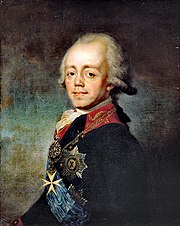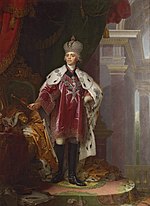Paul I. (Russia)
Paul I (actually Pavel Petrovich or Russian : Павел Петрович, born September 20 . Jul / 1. October 1754 greg. In Saint Petersburg , † March 11 jul. / 23. March 1801 greg. Ibid) was from 1762 to 1773 Duke of Holstein-Gottorf and from 1796 to 1801 Emperor of Russia , also from 1799 to 1801 Grand Master of the Order of Malta . He belonged to the House of Romanow-Holstein-Gottorp .
Life
As the son of Grand Duchess Catherine , who later became Empress Catherine II (Catherine the Great), he was recognized as a legitimate descendant by her husband, Grand Duke Peter , who later became Emperor Peter III . Unlike in the case of other children, Peter was convinced throughout his life that Paul was his biological son. There are suspicions that Paul was the child of Sergei Vasilyevich Count Saltykov , but there is no evidence to date. Paul was separated from his mother immediately after his birth and grew up at the court of his great aunt, Empress Elisabeth Petrovna . At times she even intended to make him an heir in Peter's place.
After the fall and murder of Peter III. In 1762 Paul lived with his family at Gatchina Castle with their own court and a small army, a gift from his mother. Violence he suffered in childhood and alienation from his mother made him irritable and suspicious of those around him. In 1773 his mother forced him to renounce his paternal inheritance, the Duchy of Schleswig-Holstein-Gottorf .
On the day of Catherine the Great's death, November 17, 1796, 42-year-old Paul declared himself emperor. On April 5, 1797, probably out of hatred of his mother, who had humiliated him all his life, he issued a decree that only allowed male descendants to succeed the throne. His official coronation took place on April 17th.
As if possessed by an obsession with an obsession, he decreed in all things the exact opposite of what had been ordered in his mother's time, and at the same time followed the plans of his father Peter III on many points. which the latter was unable to implement due to his murder: He amnestied those convicted by the Secret State Council, freed the political prisoners and abolished conscription. He restricted the landowners' power over the serfs and limited their compulsory labor for the landowners to three days a week. In the army of the left (just like Peter III already.) As an admirer of Prussian traditions known again Paul the soldiers braids introduce previously by Grigori Potemkin had been abolished. King Friedrich II of Prussia, who was very keen on the benevolence of the future tsar, awarded the heir to the throne Paul the highest Prussian order, the Order of the Black Eagle, in 1771 .
In foreign policy he broke away from disappointment that Charles Emanuel IV of Sardinia-Piedmont was not reinstated after the liberation of Piedmont from the rule of Napoleon , from the alliance with Austria , Great Britain , Naples and the Ottoman Empire against France and fought by his policy of armed neutrality in fact on the side of the latter. Paul also had plans prepared to attack the British territories in India. This move was believed to be a major reason for his murder.
In gratitude for the refuge in Russia, the Knights of the Order of Malta deposed their Grand Master Hompesch in 1798 and declared Emperor Paul Grand Master ( de facto , not de jure ); after his assassination (1801), a Roman Catholic grand master was again duly elected in 1803.
In front of his castle, Paul had the equestrian statue of Peter the Great set up with the inscription "To the great-grandfather of the great-grandson". Due to numerous death threats, Paul had a massive high-security castle built for his own safety (today's Michaelsburg ). A small island between the Fontanka and Moika rivers and two canals was chosen as the location .
After six years of construction, the palace became the official residence of the emperor's family on November 1, 1800. The modern castle with its drawbridges, guards, the many rooms, corridors, levels and numerous security systems did not help Paul. On the night of March 11th, Jul. / March 23, 1801 greg. Paul I fell victim to an assassination attempt by conspirators from circles of the nobility (murderer Subow , von der Pahlen ): They strangled him with his own sash after he had refused to sign his abdication. The deposition, but not the murder, is said to have happened with the silent consent of Paul's son Alexander, who came to the throne as Alexander I after the act . After the emperor was murdered, his family moved back to the Winter Palace .
Paul was buried in the Peter and Paul Cathedral in Saint Petersburg .
Marriage and offspring
In 1773 he got his first marriage to the German princess Wilhelmina Luisa von Hessen-Darmstadt (1755–1776), who was called Natalja Alexejewna after the adoption of the Russian Orthodox faith . She died on April 15th July. / April 26, 1776 greg. , two days after the birth of their first child.
On October 7th, Jul. / October 18, 1776 greg. He married the German princess Sophie Dorothee von Württemberg (1759-1828), who was called Maria Feodorovna after the adoption of the Russian Orthodox faith . She gave birth to ten children: four sons and six daughters, among them the future Emperors Alexander I and Nicholas I :
- Alexander I (December 23, 1777 - December 1, 1825), Emperor of Russia and King of Poland ⚭ Louise , Princess of Baden
- Constantine (May 8, 1779 - June 27, 1831) ⚭ Juliane , Princess of Saxe-Coburg-Saalfeld
- Alexandra (August 9, 1783 - March 16, 1801) ⚭ Joseph , Archduke of Austria
- Helene (* December 24, 1784; † September 24, 1803) ⚭ Friedrich Ludwig , Hereditary Prince of Mecklenburg-Schwerin
- Maria (February 16, 1786 - June 23, 1859) ⚭ Carl Friedrich , Grand Duke of Saxe-Weimar-Eisenach
- Katharina (* May 21, 1788; † January 9, 1819) ⚭I (1809) Georg von Oldenburg , ⚭II (1816) Wilhelm I , King of Württemberg
- Olga (born July 22, 1792 - † January 26, 1795)
- Anna (January 18, 1795 - March 1, 1865) ⚭ Wilhelm II , King of the Netherlands
- Nicholas I (July 6, 1796 - March 2, 1855), Emperor of Russia and King of Poland ⚭ Charlotte , Princess of Prussia
- Michail (February 8, 1798 - September 9, 1849) ⚭ Charlotte , Princess of Württemberg
ancestors
| Friedrich IV of Schleswig-Holstein-Gottorf | |||||||||||||
| Karl Friedrich of Schleswig-Holstein-Gottorf | |||||||||||||
| Hedwig Sophia of Sweden | |||||||||||||
| Peter III from Russia | |||||||||||||
| Peter I of Russia | |||||||||||||
| Anna Petrovna of Russia | |||||||||||||
| Catherine I of Russia | |||||||||||||
| Paul I of Russia | |||||||||||||
| Johann Ludwig I of Anhalt-Zerbst | |||||||||||||
| Christian August von Anhalt-Zerbst | |||||||||||||
| Christine Eleonore von Zeutsch | |||||||||||||
| Catherine II of Russia | |||||||||||||
| Christian August of Schleswig-Holstein-Gottorf | |||||||||||||
| Johanna Elisabeth of Schleswig-Holstein-Gottorf | |||||||||||||
| Albertine Friederike von Baden-Durlach | |||||||||||||
literature
- Valentin Zubov: Tsar Paul I. Man and Fate. KF Koehler, Stuttgart 1963.
- Bernhard A. Macek : Haydn, Mozart and the Grand Duchess. A study for the first performance of the "Russian Quartets" op. 33 in the Imperial Apartments of the Vienna Hofburg. Schönbrunn Palace Kultur- und Betriebsges.mbH, Vienna 2012, ISBN 3-901568-72-7 .
- Elena Palmer: Peter III. The Prince of Holstein. Sutton, Erfurt 2005, ISBN 3-89702-788-7 .
Movies
- 1928: The Patriot by Ernst Lubitsch with Emil Jannings
Web links
Footnotes
- ^ Leopold von Zedlitz-Neukirch : New Preussisches Adels-Lexicon , Volume 2, Leipzig 1836, p. 94.
- ↑ Archived copy ( memento of the original from January 17, 2010 in the Internet Archive ) Info: The archive link was inserted automatically and has not yet been checked. Please check the original and archive link according to the instructions and then remove this notice.
| predecessor | Office | successor |
|---|---|---|
| Catherine II |
Emperor of Russia 1796–1801 |
Alexander I. |
| Karl Peter Ulrich |
Duke of Holstein-Gottorf 1762–1773 |
falls to Denmark through the Treaty of Tsarskoye Selo |
| Ferdinand von Hompesch zu Bolheim |
Grand Master of the Order of Malta 1799–1801 |
Giovanni Battista Tommasi |
| personal data | |
|---|---|
| SURNAME | Paul I. |
| ALTERNATIVE NAMES | Romanow-Holstein-Gottorp, Pawel Petrowitsch von (maiden name) |
| BRIEF DESCRIPTION | Tsar of Russia |
| DATE OF BIRTH | October 1, 1754 |
| PLACE OF BIRTH | St. Petersburg |
| DATE OF DEATH | March 23, 1801 |
| Place of death | St. Petersburg |



